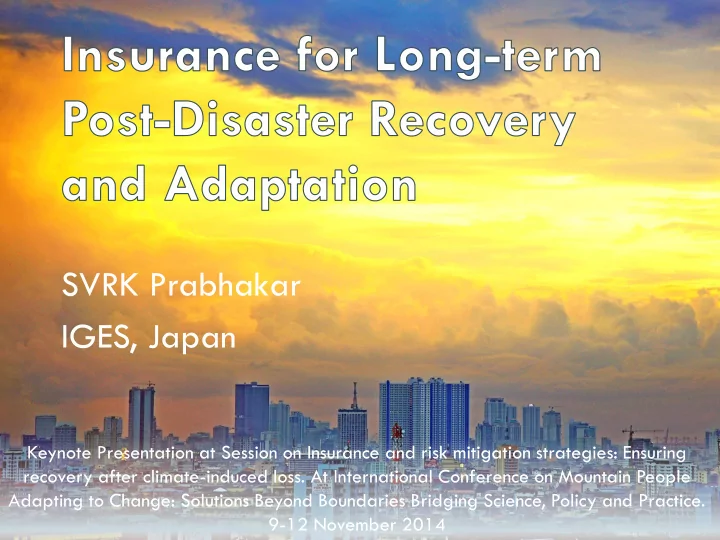

SVRK Prabhakar IGES, Japan Keynote Presentation at Session on Insurance and risk mitigation strategies: Ensuring recovery after climate-induced loss. At International Conference on Mountain People Adapting to Change: Solutions Beyond Boundaries Bridging Science, Policy and Practice. 9-12 November 2014
• Typical view of disaster • Insurance? recovery: • Though insurance is purchased before disaster, its • Infrastructure actual role is in post disaster • Health recovery. • Education • Insurance can be effective • Transportation when it is combined with • Livelihoods post-disaster reconstruction. • Agriculture • However, insurance has • Fisheries largely been missing from the • Manufacturing portfolio of post-disaster • Social capital recovery approaches. • Community building What is limiting the potential of risk insurance in post-disaster recovery? How can Insurance be effective?
• Traditional understanding of insurance effectiveness: • Has the insurance delivered the contractual obligations i.e. payoffs as agreed in the contract. Emphasis on: Affordabil • Economies of scale (How many ity/Willin gness to people are insured), pay • Avoiding moral hazard and adverse Firm’s selection, to profita • Minimize basis risk bility Risks Covered Payoff to the insured
1. Can promote emphasis on risk mitigation especially when insurance is made mandatory, proper insurance price signals are given and combined with risk mitigation measures: Insurance is largely subsidized in developing countries when present (especially in agriculture sector); In urban sector, insurance is either not mandatory or largely absent. 2. Can stabilize rural incomes: reduce the adverse effects on income fluctuation and socio-economic development: Delayed payments, insufficient coverage of hazards and losses, high basis risks 3. Can reduce burden on government resources for post-disaster relief and reconstruction: Heavy subsidization. 4. Provides opportunities for public-private partnerships. The culture of PPPs is still in infancy in most developing countries
• Farmer 1: Okinawa mainland, has <100 acres Premiums: ¥9,000 × 7 years=¥63,000 Indemnities: ¥83,000 (in 2012)= NET BENEFIT! • Farmer 2: Okinawa mainland, has area of 338a Premiums: ¥70,000 × 10years=¥700,000 Indemnities: ¥1,470,000 (in 2012)= NET BENEFIT! • Farmer 3: Irab island Premiums for 24 years= ¥3,000,000 Indemnities: ¥5,000,000 (in 2012) = NET BENEFIT! Evidence for farmers investing in better management practices?
Conceptual framework for insurance benefits IGES, 2014
Conceptual framework for insurance costs IGES, 2014 The message: Insurance can have both costs and benefits and net benefit in terms of long-term recovery is not always assured at the overall system level depending on how the insurance is designed
Vulnerable situation Adaptation situation Resilient situation Drought Drought Drought Well being Well being Well being Time Time Time Insurance payoff From Prabhakar (ed.), 2014
• How the payoffs are made and spent? • Has there been long term reduction in risks? Afford • How much losses were covered? ability Firm’s Payoff to the insured profita bility Risks Covered
• How to build political consensus on an promoting risk insurance, moving away from relief mindset to mitigation? • How to make insurance affordable to the most vulnerable while • still conveying the proper price signals and • maximizing DRR, CCA and SD benefits
Acknowledgements: The author gratefully acknowledges the financial support from the S8-3-4 Sushinhi project of Ministry of Environment, Government of Japan and Asia Pacific Network for Global Change Research (APN) under the project No. ARCP2013-SP50-Prabhakar.
• When it was combined with post-disaster reconstruction • Combining fire and earthquake insurance with reconstruction of houses • Mandatory requirement • Japan, mandatory fire and earthquake insurance with right insurance price signal has led to higher emphasis on risk mitigation leading to long-term reduction in risks • Right price signal • Avoiding subsidies (e.g. agriculture) and instead spending on risk mitigation options
• Appropriate insurance and contract design • Multi-peril and location specific insurance approaches including weather index insurance • By reducing basis risks • Mandatory combination of risk mitigation and risk spreading instruments • Reducing basis risks, lessening disaster losses • Making female members of household the beneficiary of insurance payoff • Economic empowerment and share in risk management decisions • Innovative solutions such as linking savings with insurance • Effectively high liquidity situation of households that can be used for nutrition, health and education
• IGES. 2014. Impact pathway framework for assessing disaster risk reduction and climate change adaptation benefits of agriculture insurance. IGES Research Report No 2014-xxx. Hayama, Japan: Institute for Global Environmental Strategies. • Prabhakar, S.V.R.K. 2014. Insurance effectiveness: Objectives and Expectations. Presented at Regional Consultation on Evidence for Disaster Risk Reduction and Climate Change Adaptation Effectiveness of Insurance: Challenges and Opportunities, 4-5 July, Bangi, Malaysia. • Prabhakar, S.V.R.K (Ed.). 2014. Adaptation decision making frameworks and tools: Multi- criteria decision making tools for prioritizing adaptation actions at community level. Hayama, Japan: Institute for Global Environmental Strategies. • Prabhakar, S.V.R.K., G.S. Rao, K. Fukuda and S. Hayashi. 2012. Promoting risk insurance in the Asia-Pacific region: Lessons from the ground for the future climate regime under UNFCCC. In P. Schmidt-Thomé and J. Knieling (Eds), Climate Change Adaptation – Implementing climate change adaptation strategies, Berlin: Blackwell Publishers and BaltCICA. • Prabhakar, S.V.R.K., A. Arpah, C. Claudio, and H.V. Hung. 2013. Scaling up Risk Financing in Asia and the Pacific Region: Bottom-up Lessons from Agriculture Insurance in Malaysia, Philippines and Vietnam. Project Research Report. Asia Pacific Adaptation Network, Bangkok, Thailand. • Prabhakar, S.V.R.K. and K. Fukuda. 2010. Promoting Risk Insurance in the Asia-Pacific Region: A Convergence Approach for the Future Climate Regime. In IGES Working Paper Series, 14. Hayama, Japan. IGES.
Recommend
More recommend